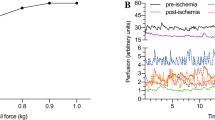Abstract
One hindlimb of mice was subjected to 60, 90 and 120 min ischemia by application of a tourniquet followed by a 60-min reperfusion period. An additional experimental group received a tourniquet for 90 min without subsequent reperfusion. The soleus muscle (from the contralateral side also as control) was removed and evaluated for muscle weight, protein weight, protein content, and glutathione concentrations. Ischemia alone without subsequent reperfusion did not produce significant changes. With postischemic reperfusion, the protein content and muscle weight increased, probably because of an increased capillary permeability, leading to muscle edema. Oxidative stress was also present during reperfusion, correlating well with the changes in protein content. The intensity of these alterations appeared to depend on the period of ischemia.
Similar content being viewed by others
References
Appell H-J, Glöser S, Duarte JAR, Zellner A, Soares JMC (1993) Skeletal muscle damage during tourniquet-induced ischemia. The initial step towards atrophy after orthopaedic surgery? Eur J Appl Physiol 67:342–347
Blaisdell FW (1989) The reperfusion syndrome. Microcirc Endothelium Lymphatics 5:127–141
Blebea J, Kerr JC, Shumko JZ, Feinberg RN, Hobson RW II (1987) Quantitative histochemical evaluation of skeletal muscle to ischemia and reperfusion injury. J Surg Res 43:311–318
Carden DL, Korthuis RJ (1989) Mechanisms of postischemic vascular dysfunction in skeletal muscle: implications for therapeutic intervention. Microcirc Endothelium Lymphatics 5:277–298
Carvalho FD, Remião F, Vale P, Timbrell JA, Bastos ML, Ferreira MA (1994) Glutathione and cysteine measurements in biological samples by HPLC with a glassy carbon working detector. Biomed Chromatogr 8:134–136
Cronenwett JL, Lee KR, Shlafer M, Zelenock GB (1989) The effect of ischemia-reperfusion derived oxygen free radicals on skeletal muscle calcium metabolism. Microcirc Endothelium Lymphatics 5:171–187
Duran WN, Dillon PK (1989) Effects of ischemia-reperfusion injury on microvascular permeability in skeletal muscle. Microcirc Endothelium Lymphatics 5:223–239
Gidlöf A, Lewis DH, Hammersen F (1987) The effect of prolonged ischemia on the ultrastructure of human skeletal muscle capillaries. A morphometric analysis. Int J Microcirc Clin Exp 7:67–86
Grace PA (1994) Ischaemia-reperfusion injury. Br J Surg 81:637–647
Hammersen F, Hammersen E (1984) The ultrastructure of microvascular endothelial cell reactions to various stimuli. Progr Appl Microcirc 6:91–108
Harris K, Walker PM, Mickle DAG, Harding R, Gatley R, Wilson GJ, Kuzon B, McKee N, Romaschin AD (1986) Metabolic response of skeletal muscle to ischemia. Am J Physiol 250:H213-H220
Idström JP, Soussi B, Elander A, Bylund-Fellenius AC (1990) Purine metabolism after in vivo ischemia and reperfusion in rat skeletal muscle. Am J Physiol 258:H1668-H1673
Kawasaki S, Sugiyama S, Ishiguro N, Ozawa T, Miura T (1993) Implication of superoxide radicals on ischemia-reperfusion-induced skeletal muscle injury in rats. Eur Surg Res 25:129–136
Lowry OH, Rosebrough NJ, Farr AL, Randal RJ (1951) Protein measurement with the folin phenol reagent. J Biol Chem 193:265–275
Menger MD, Pelikan S, Steiner D, Messmer K (1992) Microvascular ischemia-reperfusion injury in striated muscle: significance of “reflow paradox”. Am J Physiol 263:H1901-H1906
Petrasek PF, Homer-Vanniasinkam S, Walker PM (1994) Determinants of ischemic injury to skeletal muscle. J Vasc Surg 19:623–631
Phillips GD, Knighton DR (1990) Skeletal muscle regenerates. Wounds 2:82–94
Sexton WL, Korthius RJ, Laughlin MH (1990) Ischemia-reperfusion injury in isolated rat hindquarters. J Appl Physiol 68:387–392
Smith JK, Carden DL, Korthius RJ (1989) Role of xanthine-oxidase in postischemic microvascular injury in skeletal muscle. Am J Physiol 257 (Heart Circ Physiol 26):H1782-H1789
Soussi B, Lagerwall K, Idström JP, Schersten T (1993) Purine metabolic pathways in rat hindlimb perfusion model during ischemia and reperfusion. Am J Physiol 265:H1074-H1081
Sternbergh WC, Adelman B (1992) The temporal relationship between endothelial cell dysfunction and skeletal muscle damage after ischemia and reperfusion. J Vasc Surg 16:30–39
Uhlig S, Wendel A (1992) The physiological consequences of glutathione variations. Life Sci 51:1083–1094
Walker PM, Lindsay T, Liauw S, Romaschin AD (1989) The impact of energy depletion on skeletal muscle. Microcirc Endothelium Lymphatics 5:189–206
Author information
Authors and Affiliations
Rights and permissions
About this article
Cite this article
Duarte, J.A., Soares, J.M.C., Glöser, S. et al. Administration of tourniquet. Arch Orthop Trauma Surg 116, 97–100 (1997). https://doi.org/10.1007/BF00434110
Received:
Issue Date:
DOI: https://doi.org/10.1007/BF00434110




